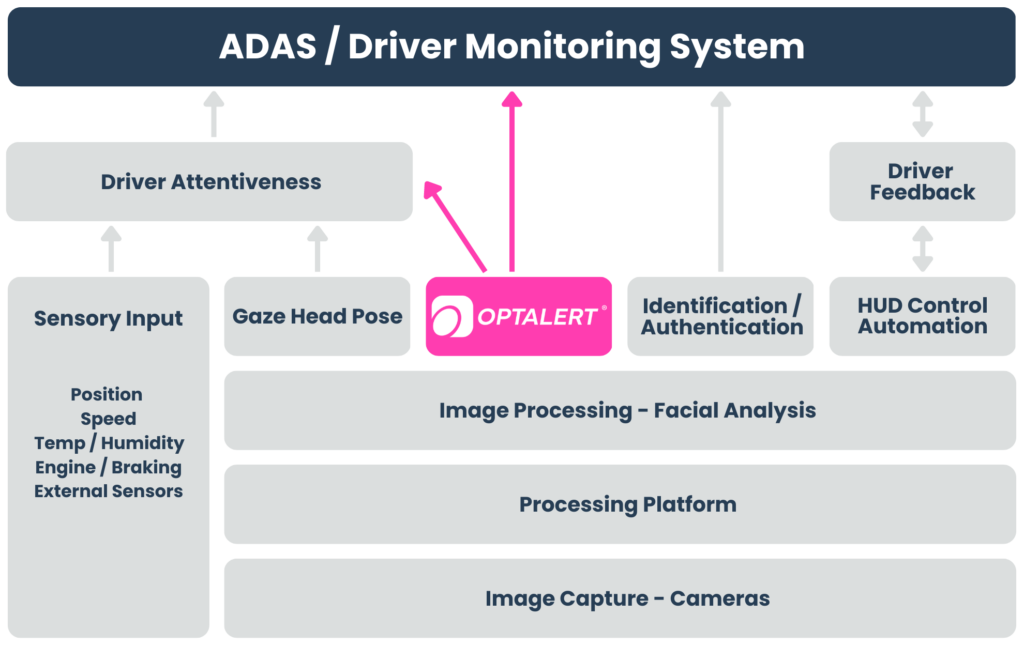Optalert Drowsiness Monitoring
A range of new features are emerging in advanced driver assistance systems. One of these is drowsiness monitoring, a safety-critical feature. If an automotive OEM gets this wrong and embeds an inaccurate system, it will generate false alarms annoying the driver who may turn it off, or worse, not detect dangerous levels of impairment and lead to tragic outcomes and an ensuing public backlash. Both of these outcomes are entirely preventable.
There are two aspects of drowsiness that can be measured:
- The Karolinska Sleepiness Scale (KSS) measures subjective tiredness. It has major issues in DMS applications because of its poor resolution and weak correlation with impairment.
- Optalert’s Johns Drowsiness Scale (JDS) quantifies cognitive impairment due to drowsiness. It is the only clinically proven neurological biomarker for predicting performance failure in a driver.
Optalert offers the gold standard in measuring driver impairment from drowsiness on the Johns Drowsiness Scale (JDS). All other systems attempt to measure subjective tiredness on the Karolinska Sleepiness Scale (KSS), an inferior ground truth that correlates poorly with impairment.
Only Optalert’s algorithm quantifies deterioration in cognitive brain function due to drowsiness. It remains the only scientifically proven, objective measurement of impairment. Our solution has been independently validated by Harvard Medical School and confirmed by over 90 independent, peer-reviewed studies.
In terms of commercial validation, our technology has been the premium choice in industrial-grade fleets for over 15 years. Optalert’s software is now available to license and we work with leading OEMs and tier 1s to integrate it into their driver monitoring systems (DMSs). Our agreements can include both developer and production licences, along with comprehensive support services.
Quantify drowsiness in the blink of an eye
Optalert’s patented drowsiness detection algorithm needs one input signal: the blinks of the driver’s eyelid. It then processes 64 characteristics of this signal to output a value from 0.0 to 10.0 on the Johns Drowsiness Scale (JDS), which spans the full spectrum of drowsiness, from alertness to sleep.
How Optalert fits into the DMS stack

Prolong wakefulness with effective countermeasures
Other driver monitoring systems detect dangerous levels of drowsiness when it’s too late. A driver at KSS 7 or 8 has already passed beyond dangerous levels of impairment. They are lucky to still be driving.
Optalert’s algorithm detects cognitive impairment due to drowsiness far in advance of these situations, allowing the vehicle to enact countermeasures that reduce impairment and prolong wakefulness. With over 15 years of experience working in the fleet industry, Optalert has a wealth of knowledge and data about effective countermeasures. Incorporating these into your driver monitoring system can reduce road accidents and save lives.
Choose the best technology and far exceed mere compliance by achieving a 5-star rating from Euro NCAP and NHTSA. Contact us to learn more about Optalert’s algorithm and how it can enhance your driver monitoring system. You can also submit your drowsiness data set below to see how it compares to the gold standard.
In just three simple steps, validate your DMS with Optalert’s world leading drowsiness system.
1
Upload your first 5 files or 180 minutes of eye-opening data.
2
Receive assessment report from Optalert.
3
Upload more data and receive full verification report from Optalert.
Want to know more?
Enter your name, email address, and your message, and we’ll get back to you as soon as possible.
You can also upload your files straight away and we will provide you with a comprehensive assessment report.
Frequently Asked Questions
Data needs to be in CSV file format. You can upload 5 files or 180 minutes of eye-opening data in total for the complimentary initial assessment.
Please ensure that the file contains five distinct columns:
- Timestamp (in milliseconds)
- Eyelid Left (eyelid opening measure; relative floating-point value from 0-1 inclusive)
- Eyelid Left Valid (Boolean, 1 or 0)
- Eyelid Right (eyelid opening measure; relative floating-point value from 0-1 inclusive)
- Eyelid Right Valid (Boolean, 1 or 0).
Each row should equate to a video frame and the video frame rate should be 60fps or higher. The minimum acceptable rate is 30 fps.
The Report on the first 5 files or 180 minutes of data is complimentary. If you need further assessment beyond the free tier, the assessment is charged at USD$10 per minute of data assessed.
This depends on several factors including the quality and quantity of your submitted data. You should receive your report within 10 business days.
